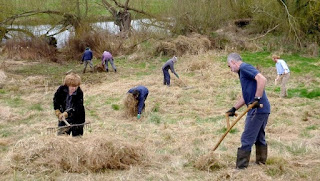 |
The Edge Hill team, breakfasted
and awaiting entrance to
the Jodrell lab at Kew.
|
"University Challenge typically involves images of knowledgeable
young men and women sweating worriedly under the combined glare of the studio
lights and Paxman’s questions.
It was with the aim of imparting such torture
and of raising the profile of botany in UK universities that Jonathan Mitchley
and John Warren developed the idea of Botanical University Challenge last year.
As a result of this initiative, the early hours of 10th
March 2016 saw a car load of expectant students leave Edge Hill University with
their Head of Department cum chauffeur. Discussion along the way predominantly
focused upon the meaning of scientific Latin and speculation about what other
rounds may feature. That and which services we were stopping at for breakfast.
 |
Cards all ready, awaiting the draw!
|
Once breakfasted and arrived we joined similarly expectant
teams from Aberystwyth, Kew, Reading and Southampton, ready to do practised battle.
Rounds did feature botanical Latin alongside a full range of other areas;
plants in the bible, plants and drinks, Welsh common names – the clue was in
the descriptions - and a round or two on identification.
James Wong proved a friendly, less intimidating question
master than Jeremy Paxman. He also added his own twists to various rounds by adding
snippets of information to any ethnobotanical round and providing a final
arbiter of the suitability of some questions, “next round is sedge
identification, who thought that was a good idea? That’s too difficult, we
aren’t having that. Let’s go to the next set of questions”!
 |
| The Edge Hill team in action |
There were undoubtedly some very knowledgeable individuals
representing the various institutions. Though handling the pressure and knowing
when to hit the bell were equally important.
All teams acquainted themselves
well before Reading emerged eventual winners. Edge Hill’s pain at failure was
eased by one of our graduates appearing on the victorious team. Although, we
haven’t forgiven him for such treachery!
 |
The teams are introduced to the audience
|
Thanks go to RBG Kew for hosting and to Jonathan and John
for organising. We look forward to the next one in November 2017. We have already
started revising our botanical Latin and our plants in Shakespeare. Roll on autumn".
Thanks to Paul for telling us about Botanical University Challenge. Don't forget to get in touch with him if you would like to take part this autumn.

















